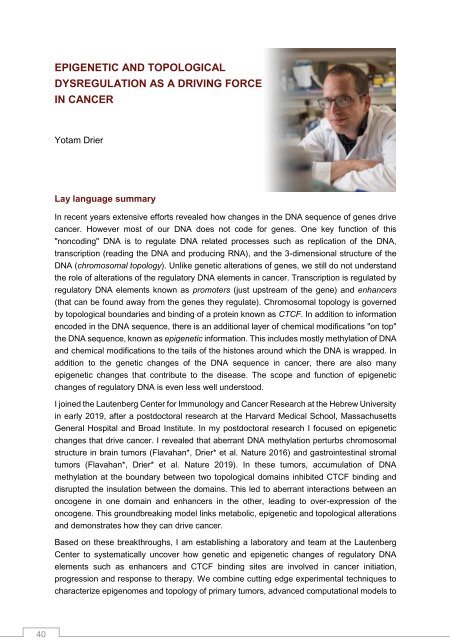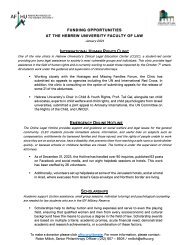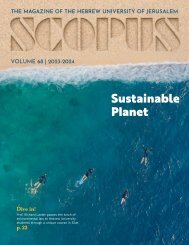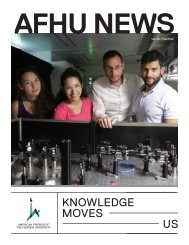You also want an ePaper? Increase the reach of your titles
YUMPU automatically turns print PDFs into web optimized ePapers that Google loves.
EPIGENETIC AND TOPOLOGICAL<br />
DYSREGULATION AS A DRIVING FORCE<br />
IN CANCER<br />
Yotam Drier<br />
Lay language summary<br />
In recent years extensive efforts revealed how changes in the DNA sequence of genes drive<br />
cancer. However most of our DNA does not code for genes. One key function of this<br />
"noncoding" DNA is to regulate DNA related processes such as replication of the DNA,<br />
transcription (reading the DNA and producing RNA), and the 3-dimensional structure of the<br />
DNA (chromosomal topology). Unlike genetic alterations of genes, we still do not understand<br />
the role of alterations of the regulatory DNA elements in cancer. Transcription is regulated by<br />
regulatory DNA elements known as promoters (just upstream of the gene) and enhancers<br />
(that can be found away from the genes they regulate). Chromosomal topology is governed<br />
by topological boundaries and binding of a protein known as CTCF. In addition to information<br />
encoded in the DNA sequence, there is an additional layer of chemical modifications "on top"<br />
the DNA sequence, known as epigenetic information. This includes mostly methylation of DNA<br />
and chemical modifications to the tails of the histones around which the DNA is wrapped. In<br />
addition to the genetic changes of the DNA sequence in cancer, there are also many<br />
epigenetic changes that contribute to the disease. The scope and function of epigenetic<br />
changes of regulatory DNA is even less well understood.<br />
I joined the <strong>Lautenberg</strong> <strong>Center</strong> for Immunology and Cancer Research at the Hebrew University<br />
in early 2019, after a postdoctoral research at the Harvard Medical School, Massachusetts<br />
General Hospital and Broad Institute. In my postdoctoral research I focused on epigenetic<br />
changes that drive cancer. I revealed that aberrant DNA methylation perturbs chromosomal<br />
structure in brain tumors (Flavahan*, Drier* et al. Nature 2016) and gastrointestinal stromal<br />
tumors (Flavahan*, Drier* et al. Nature 2019). In these tumors, accumulation of DNA<br />
methylation at the boundary between two topological domains inhibited CTCF binding and<br />
disrupted the insulation between the domains. This led to aberrant interactions between an<br />
oncogene in one domain and enhancers in the other, leading to over-expression of the<br />
oncogene. This groundbreaking model links metabolic, epigenetic and topological alterations<br />
and demonstrates how they can drive cancer.<br />
Based on these breakthroughs, I am establishing a laboratory and team at the <strong>Lautenberg</strong><br />
<strong>Center</strong> to systematically uncover how genetic and epigenetic changes of regulatory DNA<br />
elements such as enhancers and CTCF binding sites are involved in cancer initiation,<br />
progression and response to therapy. We combine cutting edge experimental techniques to<br />
characterize epigenomes and topology of primary tumors, advanced computational models to<br />
40

















